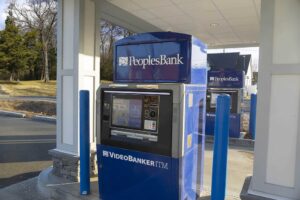
A PeoplesBank VideoBanker ITM at an unspecified branch's drive-through. The bank said it plans to add “at least” four of the units to its branches in the Hartford metro area. Photo courtesy of PeoplesBank
More and more banks are turning to video teller-assisted ATMs – or interactive teller machines – to carry out simple transactions as they refashion their physical branches to offer higher-touch service.
ITMs look like ATMs, but have more features. Through video chatting with a teller – who is sometimes located in a bank’s call center – ITMs can help people complete transactions usually done inside bank branches, such as cashing a check and depositing it to different accounts.
Hanover-based Rockland Trust Co. announced this summer it was planning to grow its usage of ITMs by one third as it “transformed” eight branches over the next year. The same week, Holyoke-based PeoplesBank said it was adding four or more to its Connecticut branches. Citizens Bank is even replacing some of its small grocery store branches with the devices.
Aleda deMaria, PeoplesBank’s executive vice president of consumer banking and operations, said that when the bank opened its first two ITMs in September 2019, it was met with uncertainty from both customers and employees about the machines replacing human jobs.
“At first, around four years ago, customers didn’t want their tellers taken away. They thought that, ‘If I use this, my teller is going to lose their job.’ Or as an associate, ‘If I push this and train customers to use it, am I going to lose my job?” she said.
Education Helps Public See Convenience
But as the bank continues to put up ITMs and conducts efforts to educate customers about the machines, deMaria said ITMs are not displacing any jobs – even as some branches see more customers using ITMs than walking into the lobby. Customers at the bank’s South Windsor, Connecticut branch, which opened earlier this year, are already doing 55 percent of their transactions through the branch ITM.
“Associates are now helping customers by hearing their concerns and focusing on true relationship-building. The perceived issues of the customer – of whether they are going to use it, or are the associates going to lose their jobs – we’re past that. Now our challenge is more on, do we upgrade the machines, the tech and software?” deMaria said.
DeMaria said people in different age groups use the ITMs once they see the benefit of convenience, more so with older people who might have a hard time getting out of their cars and the on-the-go moms with kids in the car who want to quickly process a bank transaction without leaving their cars.
Rockland Trust also reported good ITM usage at its downtown Boston branch, with 80 percent of the transactions at the 93 Franklin St. branch coming from the ITMs. The bank said it is currently looking at putting up more drive-through ITMs at convenience spots in metro areas.
Charlie Miller, executive vice president and director of sales and business development for East Hartford, Connecticut branch design, construction and consulting firm Solidus, said customers who live in large urban areas are “more likely to prefer the convenience and efficiency of ITMs, while customers in small, rural areas are often reluctant to embrace these new ways of conducting business.”
Not for Cost Savings
Banks usually put up ITMs in the same address as their physical branches, or as a complementary unit in a separate location. But some have replaced bank branches with ITMs outright.
Citizens Bank moved in August to close down five branches in Stop & Shop stores in Massachusetts, replacing them with ITMs.
DeMaria said PeoplesBank believes ITMs are more aligned with a “service strategy, and not a growth strategy.”
“I really challenge financial institutions that are looking to do this to define: Why are you doing this? Because the ones that call me to talk about it and say, ‘Well, how much deposit growth did you get?’ I’m going to say, that’s not why you do this,” she said.
“It is an expense without the immediate and direct benefit of deposit and loan growth like branches, so you have to look for other reasons. And I think a lot of financial institutions have a hard time defining that strategy and then accepting that it is a service strategy, not a growth strategy,” she added.
Solidus’s Miller said that ITMs will not replace bank branches as the visiting physical branches and offices still provide “an additional level of privacy, confidentiality,” and personalization that online banking, ITMs or other tech solutions may not provide.
“Physical branches will always be relevant. Even today people still choose their banks based on location and the number of branches in their area. Customers want to know that they can access their bank in-person without having to travel long distances,” he said.

Nika Cataldo
Evolution of Bank Branches
PeoplesBank’s use of ITMs to change how their branches work appears to be in line with broader industry trends Miller described. At banks that put up ITMs, the role of branches is evolving into a place to provide personalized and in-depth financial advice and decisions to individual and business customers.
Branches used to have to accommodate streams of foot traffic – mainly for withdrawals and deposits – needing a large number of workers to staff 10 or more teller lines. But demand for a faster and more convenient banking experience led to banks offering self-service options for simple transactions through tablets or other technologies, Miller said, including ITM units inside branches.
Branches now also devote more square footage to private offices and lounge spaces for the customers and bankers to talk in a secure and confidential place about financial advice that is tailor-fit to the customer, Miller said.
“Sweeping technological advancements in the digital age have led to many changes in traditional banking practices. Today’s customers no longer need to come into a bank to perform basic transactions. Because of this, branch services have become increasingly more consultative and educational, rather than transactional,” he said.
Patrick Myron, Rockland Trust’s senior vice president of retail network strategy and sales analytics, said he believes that ITMs will be widely used by the public in the near future due to the convenience and efficiency they provide.
“We’re not there yet, but that is the trajectory that we’re seeing. ITMs will just be as common to use as airport check-in kiosks,” Myron said.




 |
| 